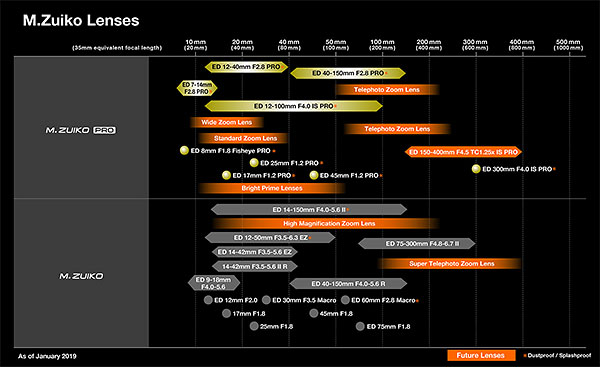Olympus Q&A @ CP+ 2019: Finally! Why the E-M5 III is running so late, and why not to worry
posted Monday, March 4, 2019 at 12:45 PM EDT
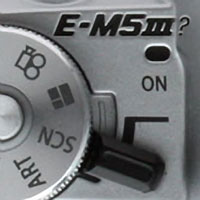
A lot of readers (and our own staff!) have been wondering what's up with Olympus' E-M5 line, given how long it's been since its last update. We got to talk with senior Olympus management at the CP+ 2019 show in Yokohama, Japan yesterday, and not only learned the likely reason for this, but also that the company is very emphatic that its E-M5 lineup isn't going anywhere, and to expect an update soon. (Although, as always with camera manufacturers, they declined to define just what "soon" constituted. ;-)
Participating in the discussion on behalf of Olympus Corp. were Shigemi Sugimoto, Head of the Imaging Business Unit; Toshiyuki Terada, General Manager of the Global Marketing Department, Imaging Global Marketing Division; and Yuka Iwasawa of the Public Relations and Investor Relations Department. Here's the content of that discussion!
Dave Etchells/Imaging Resource: The first question is about the E-M1X and its new AI autofocus. How is it being received by the market? What are you hearing back so far?
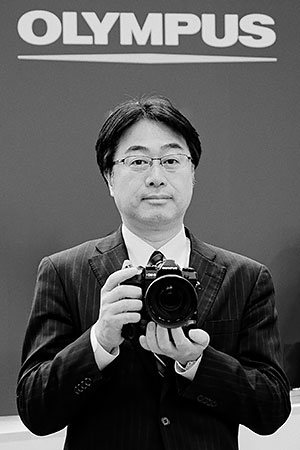
Head, Imaging Business Unit
Olympus Corp.
Shigemi Sugimoto/Olympus Corp.: The application of AI technology has been well-received for the market, and we appreciate that approach to give this new technical challenge has been highly evaluated. The essence of this camera is the improvement of best performance and reliability, and through the evaluation of its intelligent subject recognition plays an important role. We are getting a positive feedback from professional photographers that focusing performance of C-AF tracking has been improved from E-M1 Mark II C-AF tracking.
DE: They're noticing a significant improvement. Hmm.
Toshiyuki Terada/Olympus Corp.: Always, the market is advancing with the new technology, like intelligent phase-detection technology. But as he said, to get the benefit, the basic autofocus tracking performance, that is really, really important. I think the combination of those two is really the key for success. I think that we have a good start for that kind of new technology, the fundamental performance.
DE: And so you said the, the basic autofocus has improved. Not just the AI, but your basic tracking has improved significantly?
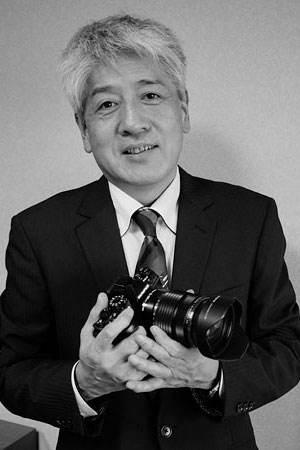
General Manager, Global Marketing Department
Imaging Global Marketing Division
Olympus Corp.
TT: Sure. I most of our professional photographers who used the E-M1 Mark II, they have all said that they feel an amazing improvement.
DE: Oh, really; an amazing improvement? That's interesting, because the E-M1 II was already pretty good.
It's funny, we've mostly been focused on the big new feature, which was AI, but it's good to know that the basic AF has improved also.
Moving on to lenses, we've seen activity at completely different ends of your lens lineup. FIrst the 150-400mm development announcement, and then the 12-200mm is kind of a vacation lens. They're in such completely different directions, it's hard to have a sense of where Olympus is going with lens development. What can you say about that?
SS: As we have shown in our lens roadmap, Olympus has already focused on three points. First, enriching the telephoto shooting lens for all users from professional to entry users, by taking advantage of Micro Four Thirds characteristics. Second, to develop high-speed prime lenses for professionals and high amateurs. Third, to enrich zoom lenses in the pro category that only Micro Four Thirds can offer. We try to develop several lenses every year. Of course, there will be pro lenses released before the 150-400mm pro launch in 2020. Please be on the lookout for more information for what's coming. But I say again, we launch new lenses every year...
DE: Understood; three main areas, telephoto for everyone, both pros and amateurs. High-speed, large-aperture primes at the higher-end.
SS: Sure.
DE: And then you said lenses that you really only can do in Micro Four Thirds...
SS: Especially for professional lenses.
DE: Especially professional.
SS: If you see our lens roadmap, there's a professional zoom lens we're showing, too.
DE: Ahh. OK.
SS: That's a message: to enrich the professional zoom-lens category, we will, create something unique.
DE: Mmm, and "things that take unique advantage of Micro Four Thirds" means you can make longer-ratio or larger-aperture than you could do on full-frame, for instance... <they nodded in agreement>
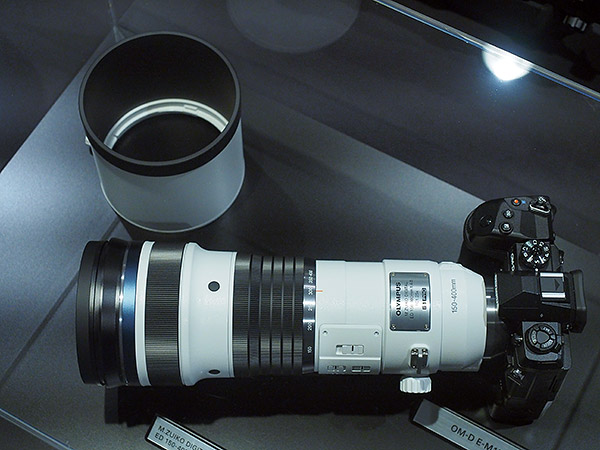
This next one is a very important question, I think, because we have had a great deal of interest and concern expressed by readers...
<laughter>
DE: Our own staff has felt that...
Yuka Iwasawa/Olympus Corp.: We've read the article.
<laughter>
DE: Haha, yes. I'm sure you've read it. <laughs>
YI: <laughs>
DE: That article got more reader response and reaction than anything we've written in the last five years, probably.
TT: <laughs> I see!
YI: Wow.
DE: So yeah, what, what is going on with your prosumer [cameras]? It feels a little bit like the middle has been abandoned, that you have the E-M10 III, and you have the E-M1-series, and... I don't know. I'll just leave it at that, and ask you what you can tell us, or what you can say.
SS: While we can't give you the details for future products, we will continue with current product lineup strategy with successor models.
DE: Mmm.

SS: As you know, E-M5 line was the first OM-D series, and it is important to the lineup for mid-range users that would express the strength of Olympus' system. We can reassure you that we plan to introduce a successor model.
DE: Mmm. So there is one coming.
SS: Yes.
DE: Hmm.
<laughter>
TT: It's really clear, your influence on others, because this morning also, we were asked the same question, based on your article.
DE: Oh, based on our article! <laughs>
YI: Yeah.
TT: Some other press in consumer area. <laughs> A very influential article.
DE: I think it's a big problem, because existing E-M5 owners, maybe they're OK still, but someone who wants to buy into that part of the line, they don't want to buy an E-M5 II, because they know something must be coming. But on the other hand, some of the readers responded "Oh, I gave up waiting, I'm going to go with some other manufacturer now."
TT: Yeah, from that sense, I think, thank you for your article. It's very good timing to say something from our side.
DE: ...to say something to influence that. And so at this point, all you can say is something is coming, but we can't say when.
TT: Our message is that the existing lineup, we should continue with the successor model. That is our message.

DE: And I guess it would make sense that it would be soon, because it's been a long time and the E-M1X is out now, so...
<laughter>
DE: ...but I don't know, there's an American idiom where when someone says "It's coming soon," someone else says "Yeah, so's Christmas." It's like "Yeah, that's coming soon, but when?"
<laughter>
DE: But I understand you can't say more. Still, just saying strongly that the line will continue is important, I think.
SS: Yes.
TT: Sure.
DE: So in a conversation I had with Aki-san from the US, he had said that he sees one of the biggest challenges is just to get people to be thinking about Olympus, and have you in their minds more. Especially with all of the focus on full-frame, Sony, Canon, Nikon and now Fujifilm have had new models coming out, I feel like Olympus has gotten lost a little bit in people's minds. Do you see that as being true elsewhere in the world too, besides the US? And what is your strategy for bringing Olympus back to the front of people's minds?
SS: At the global launch event of the E-M1X, we delivered our message of focusing on Micro Four Thirds system and our core competencies. Thanks to you and other media, our focus on Micro Four Thirds was well-communicated to the market. And we now are seeing positive effects on the sales of E-M1 Mark II.
William Brawley/Imaging Resource: Mmm!
SS: Yeah. Very good. Going forward, we will continue to communicate to users from entry users to professionals, that the three core strengths of Olympus brand are compact and lightweight, high-resolution lenses, and strong image stabilization. So we focus our message to customers on these three points.
DE: Mmm, mmm. And you said you think since that interview with Aki-san and him articulating that, it has been since then you have seen E-M1 Mark II sales become stronger?
SS: Sure.
DE: And so I guess from there it's up to marketing now to communicate those points. I mean from our view, those are certainly strong points.
TT: I think in the last year, we were very silent compared to the others. That's one reason somehow that people are hesitating to purchase our product. I don't know, I'm just guessing. But that kind of strong message about our business, I think somehow that is satisfying to our customers. Thanks for your help. For example, for the existing customers, it's really helpful.

DE: Mmm, yeah. I think certainly that is one thing that happened, at least in the US I think there is no advertising for the Olympus brand. And so I think it was easy for other things to occupy more people's attention. And those are definitely three strong points, that your lenses are excellent ones. Especially the 12-100mm is my favorite lens on any platform.
<appreciative laughter>
DE: And also, your image stabilization is extremely strong. And then, of course, compactness. So yeah, it seems like if you want people to think of Olympus as something to buy, having those strong points communicated out there, it's going to be very important.
TT: Yeah, that's right. That's the reason to choose Olympus.
DE: Yes.... As you know, weather-sealing is a passion of mine. <chuckles>
TT: <laughs>
DE: Anyway, it's interesting to me; you are very strong on weather-sealing on your higher-end models, basically the E-M5 and up. But on the lower-end products you don't make any statement at all. But I feel that even casual users would appreciate not needing to worry about their camera not working if it gets wet. Do you see extending the concept of your core value of ultimate reliability to less-expensive models also?
SS: As we don't tend to hear strong requests for weather-sealing for the E-PL series, and in keeping with the design concept of it's compact sizing, we are not currently planning to add weather-sealing at this time. However, if we hear more requests from users, we will look at this then to study the demand.
DE: I think that at the low-end, you probably won't hear it as a strong request, even though it's a concern in people's minds. I think it's not something that an entry-level user would think, "Oh, I want a weather-sealed camera."
TT, SS, YI: Mmm.
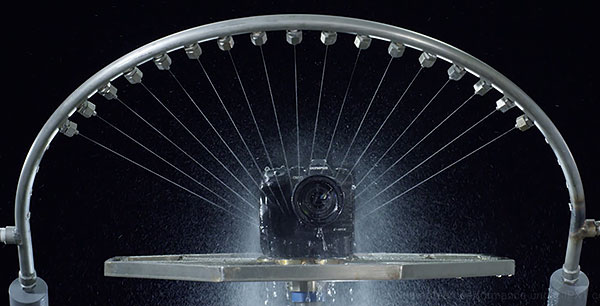
DE: But they would still be nervous about taking a camera into the rain.
WB: Yeah. They might not necessarily go looking for a weather-sealed camera, but they would certainly appreciate having that feature there from the get-go.
TT: Mmm.
DE: If a manufacturer could say, "This camera, you don't have to worry (quite so much) about," I think that would be a differentiating point, even for entry-level users, a reason to go with one brand or another.
SS: Thank you for the information.
TT: Yes, thank you.
DE: Changing topics entirely, we're fortunately a long ways now, past the time when Olympus had difficult financial challenges. I don't follow companies' financial reports myself, but I'm curious: How are Olympus' current financial numbers looking? And what can you tell readers about overall year-to-year performance, especially camera and photography. What does the future hold?
SS: Our imaging business forecast in this financial year was tough, and resulted in operating loss due to the effects of production system reforms. We are changing our production factory from Shenzhen, China to Vietnam also.
DE: Oh, to Vietnam?
SS: Yeah. So next year our performance will benefit from these changes, because labor cost is cheaper there than China.
DE: Yes, yes.
SS: We aim to recover by introducing new value products built around Olympus' uniqueness. And there are two points for manufacturing restructuring: The labor cost should change from China to Vietnam, and we had to focus on moving lots of machinery from China to Vietnam. So many technicians had to focus on such distraction -- so as you know, we cannot show new products during this period. That's the reason.
[Ed. note - Something that's obvious, but hadn't occurred to me: When you move the factory, besides just the issue of the machinery being offline during the transition, technicians who'd otherwise be involved maintaining the production line are tied up tearing down the old one and setting up the new one, getting everything dialed in, etc. So even if you stage the transition, and have parts of production still running while others are being moved, your capability is going to be impaired, because the staff needed to keep everything running in tune is tied up making the move. In Olympus' case, there'd be times when a remaining line in Shenzen might be operating, but the people needed to maintain it would be in Vietnam, getting the new line up and running there. I can't begin to comprehend what a move of this sort must involve. Yet the rise in Chinese labor costs has been so great that even the massive investment required to move production was more than worth it. I've read a lot about how higher labor costs are resulting in companies moving production out of China, but this was the first time I talked with execs at a company that actually made the move. Smarter people than me have said it: China's economy is going to have a hard time of it, as this trend continues.]
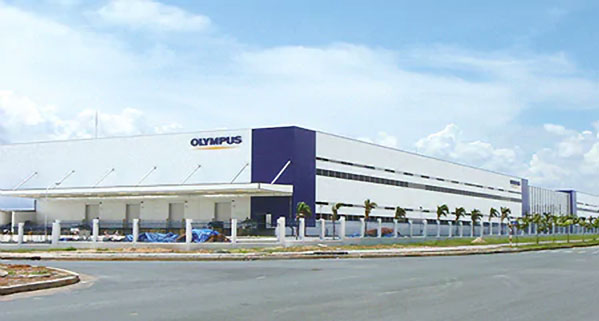
DE: Oh, that's very interesting!
WB: Ah, so this is like a transition period, from shifting production.
DE: And that has had an impact on your product releases, because you needed...
SS: Yeah.
WB: There was a time when Shenzhen wasn't up and running and...
DE: Yeah, and Vietnam still wasn't up, but you were transitioning away from Shenzhen.
SS: But that change is almost up.
DE: Almost complete. Mmm-hmm.
SS: So we hope we can change to that situation better than now.
DE: Very interesting. That must be enormously expensive. I mean, I can just imagine the logistics of moving the whole factory.
SS: Big project.
DE: Yeah, wow. How long ago did you begin that process of moving?
SS: Starting from two years ago.
DE: Two years ago. Wow.
SS: But we kept that information secret.
[Ed. Note: This is HUGE! Finally, we know the reason for the long delay in the E-M5 III. They felt that they had to prioritize fleshing-out their line with a true professional-level model (the E-M1X), but they were highly constrained in their ability to launch new models, because they were moving the bulk of their manufacturing from Shenzen to Vietnam. I have a hard time comprehending what must be involved in a move of that magnitude, there are just *so* many finely-tuned processes that go into manufacturing cameras and lenses, that also need a highly trained labor force.
As always, they wouldn't say anything specific about when we might see an E-M5 III, but knowing that they were executing an enormous manufacturing shift over the last two years leaves me feeling a lot more confident about that part of their lineup, and that we should in fact be seeing a new model relatively soon. This was one of those situations where I learned a new tidbit of information, and all of a sudden, a lot of things that didn't make sense suddenly fell into place.
So good news: The E-M5 lives, there was a very good reason for its delay, and I think we'll see the E-M5 III sooner rather than later, now that the big manufacturing move is nearly complete!]
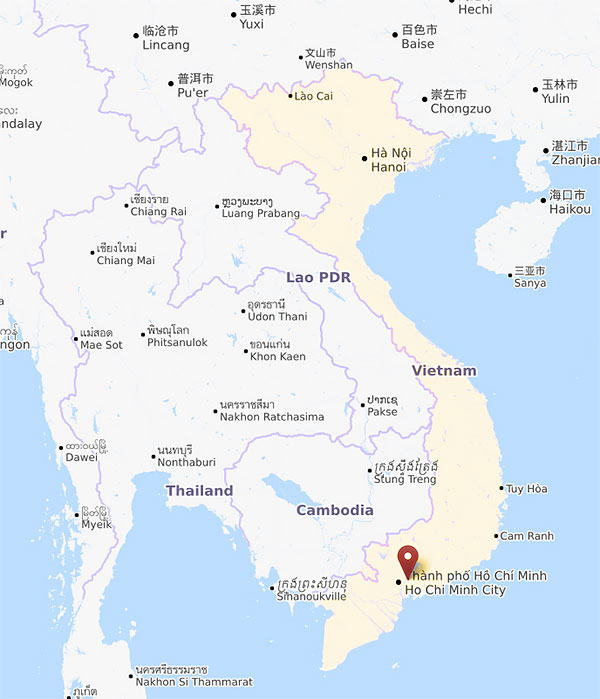
DE: Yeah, you didn't disclose it, wow. I don't know Vietnamese geography, but where in Vietnam is the plant located, do you know?
SS: Next to Thailand.
DE: Oh, near Thailand, hai!
SS: You've never been to Vietnam?
DE: I've never been to Vietnam. I've been to Thailand only once. Sony took some of us there to their Chonburi factory, outside of Bangkok. I've never been to Vietnam, though. I love Vietnamese food!
<laughter>
DE: ...but I've never been. I also love Thai food. But I've never been to Vietnam. Actually, I bet our readers would be extremely interested in seeing something about your Vietnam factory!
SS: Yeah. Currently, we have had two factories, Shenzhen and Vietnam. But the main factory was in China, but we're shifting to Vietnam.
DE: Ah, so you had production in Vietnam already, but it was just a small portion.
SS: Yeah.
DE: Ah, I see. It's interesting, too, that you said that now that you have made this transition to the new factory, it will let you develop more "value" products. Like, maybeit will be easier to build entry-level models that would be competitive.
TT: Especially the high-class lenses.
DE: Oh, really, the high-end lenses are there?
TT: Yes. It's really tough to move to the new factory because of the know-how to manufacture these. That's really challenging, right? For us to shift that kind of technology.
DE: Yeah, I know, especially things aspheric molding requires a lot of expertise and, I think, probably skill.
TT: Mmm.
WB: So then those high-end lenses that were being produced in Shenzhen and now moving to Vietnam, will all the components be entirely...
TT: We try to move to it now, but yeah.
WB: So everything will be produced in Vietnam. OK, so...
TT: But yeah, still we need to consider how to manage that kind of technology.
DE: Ahhh, so that is still a challenge, to be able to shift the very high-end productcion, yes. Is your goal eventually to have all manufacturing in Vietnam?
SS: Mainly. Partly, we are also thinking about "Made in Japan".
DE: Oh, some made in Japan? Really!
SS: Part, part...
WB: Yeah, there are still a few, like some prime lenses say "Made in Japan", I remember.
SS: It's especially difficult; higher-level lenses, we consider making them in Japan.
DE: Mmm, you're considering making those. So some are not being made there currently, you will move some to Japan, or...?
SS: We have some factories in Japan, and we have one factory in Nagano prefecture. A long time ago, we produced camera bodies and lenses in Nagano prefecture, in the Nagano facctory. So we are trying again partly...
DE: Mmm, so you had moved some production there (to Japan). Very interesting.
SS: Yeah. But mainly Vietnam.
DE: Mainly Vietnam, hai.
So my final question is: If you had to express your overall strategy for the next two to five years in just a few sentences, how would you describe that?
SS: As you know, we have a product roadmap for mid- to long-term, and each technology component has has also been assigned as a plan. (Our lens roadmap we have disclosed.)
DE: Yeah. And that roadmap just said "professional zoom", but the specifics weren't there yet.
SS: Yeah, we are continuously studying and developing products with "world's first technology", or "the world's best performance", as you saw in your E-M1X, with the world's best 7.5 steps of compensation performance.
DE: Mmm, mmm.
SS: Our overall strategy can be summarized in three points. First, develop technology that will further differentiate Olympus from its competitors. Second, further communication to the market about our core competencies: Compact and lightweight, high-resolution lenses and strong IS. Third, contribute as a group-wide technology driver, applying technologies acquired in imaging business to other business.
DE: Mmm.
SS: As you know, we have three business domains in Olympus: Medical, Scientific and Imaging. Especially, our business is medical. [Ed. Note: He means that the majority of their business volume and profits comes from their medical division. Olympus dominates the world market for endoscopes.] But the life-cycle is very long, so first, we acquire the new technology [for the Imaging division], and then it passes to medical imaging.
DE: Ah, that's interesting: Because cameras and imaging have a faster product cycle, you can innovate more there, and then that technology goes back into medical.
SS: Yes, right.
DE: Ahhh! Interesting. And medical is endoscopes and microscopes, mainly, I think?
SS: Endoscopes. Microscopes is part of Scientific.
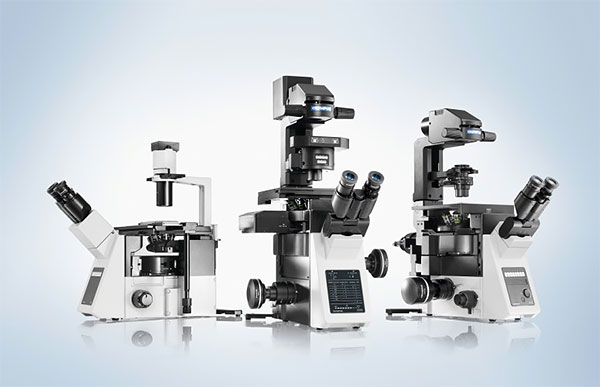
DE: Oh, I see. Scientific imaging is microscopes, ah. Maybe this would best be part of the conversation with the engineers that I will have next week, but it would be interesting to know some examples of how technology has transferred from photography into medical, or what specific things were developed? Was it a manufacturing technique for assembling lenses, or was it extreme aspheric molding? I'd be curious to know. I don't need the answer today, but it occurs to me that this would be interesting to our readers.
TT: Sure.
DE: So really, this seems like an important part of the strategy... As you say, to continue to innovate and develop world's first or world's best technology, but also part of the strategy is to communicate what Olympus means, the three strengths that you talked about.
Well, I think those were the questions we had...
WB: The other questions we had were technical. [And so will be part of a tech discussion with Olympus' senior engineering management at their R&D headquarters in Hachioji next week.]
[Ed. Note: After the recorded conversation, Sugimoto-san mentioned that some expertise also flows from the Medical division back to Imaging. He noted that the grip design for the E-M1X actually came from the Medical division's experience in designing grips for their endoscopes. There, doctors spend entire days holding the grips of endoscopes, so ergonomics are incredibly important. Their experience fine-tuning grip ergonomics for endoscopes helped inform the design of the grip on the E-M1X. This was a kind of experience-sharing that had never occurred to us, but it made a lot of sense, once it was explained to us. So technology doesn't just flow from the Imaging to Medical divisions within Olympus, but some experience goes back the other direction as well.]
Summary
As always, this was an interesting interview. (When do I ever say an interview was boring, though? ;-) But this was an especially interesting one to me, because it finally gave a clear explanation for why the E-M5 III has been so long in coming, namely that Olympus was moving the majority of their manufacturing from Shenzen, China, by expanding an existing factory in Vietnam. Olympus has said before that the E-M5 line would continue, but this time not only re-emphasized that point, but gave an explanation for why the update has been so long in coming.
It was especially interesting, though, that this explanation came not in response to my questions about the E-M5 III directly, but rather as part of a discussion about their financial performance. Honestly, I asked that question just out of personal curiosity, rather than thinking it would produce anything of great interest to our readers. (I'm selfish that way, sometimes ;-) But it turned out that that idle question turned up the most interesting bit of information of the entire interview.
However it came about, I was glad to finally have a cogent answer as to why the E-M5 III has been so long coming, and to have a solid basis for believing that it will in fact be coming soon :-)
